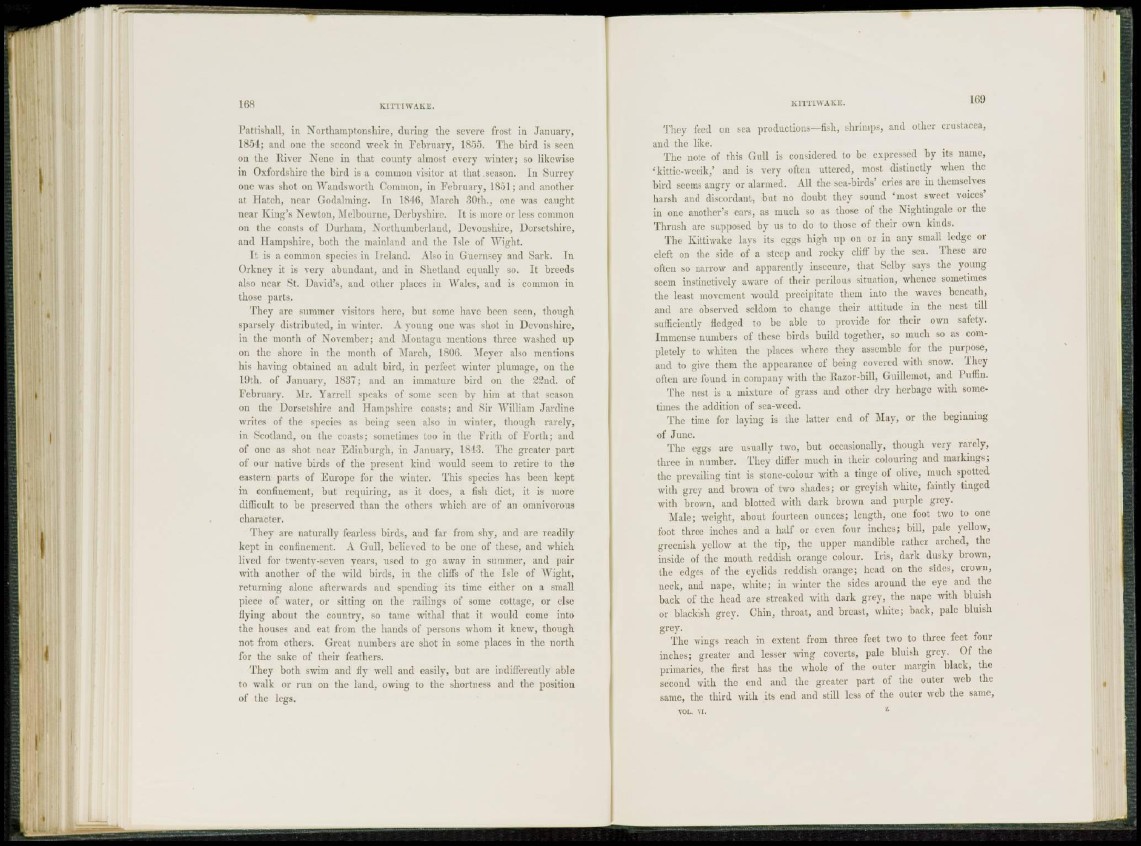
168 KITTIWAKE.
Pattishall, in Northamptonshire, during the severe frost in January,
1854; and one the second week in February, 1855. The bird is seen
on the River Nene in that county almost every winter: so likewise
in Oxfordshire the bird is a common visitor at that .season. In Surrey
one was shot on Wandsworth Common, in February, 1851; and another
at Flatch, near Codahning. In 1846, March 30th., one was caught
near King's Newton, Melbourne, Derbyshire. It is more or less common
on the coasts of Durham, N orthumberland, Devonshire, Dorsetshire,
and Hampshire, both the mainland and the Isle of Wight.
I t is a common species in Ireland. Also in Guernsey and Sark. Tn
Orkney it is very abundant, and in Shetland equally so. It breeds
also near St. David's, and other places in Wales, and is common in
those parts.
They are summer visitors here, but some have been seen, though
sparsely distributed, in winter. A voting one was shot in Devonshire,
in the month of November; and Montagu mentions three washed up
on the shore in the month of March, 180G. Meyer also mentions
his having obtained an adult bird, in perfect winter plumage, on the
19th. of January, 1837; and an immature bird on the 22nd. of
February. Mr. Yarrell speaks of some scon by him at that season
on the Dorsetshire and Hampshire coasts; and Sir William Jardine
writes of the species as being seen also in winter, though rarely,
in Scotland, on the coasts; sometimes too in the Frith of Forth; and
of one as shot near Edinburgh, in January, 1843. The greater part
of our native birds of the present kind would seem to retire to the
eastern parts of Europe for the winter. This species has been kept
in confinement, but requiring, as it does, a fish diet, it is more
difficult to be preserved than the others which are of an omnivorous
character.
They are naturally fearless birds, and far from shy, and are readily
kept in confinement. A Gull, believed to be one of these, and which
lived for twenty-seven years, used to go away in summer, and pair
with another of the wild birds, in the cliffs of the Isle of Wight,
returning alone afterwards and spending its time either on a small
piece of water, or sitting on the railings of some cottage, or else
flying about the country, so tame withal that it would come into
the houses and eat from the hands of persons whom it knew, though
not from others. Great numbers are shot in some places in the north
for the sake of their feathers.
They both swim and fly well and easily, but are indifferently able
to walk or run on the land, owing to the shortness and the position
of the legs.
KITTIWAKE. 160
They feed ou sea productions—fish, shrimps, and other crustacca,
and the like.
The note of this Gull is considered to be expressed by its name,
'kittie-wceik,' and is very often uttered, most distinctly when the
bird seems angry or alarmed. All the sea-buds' cries arc in themselves
harsh and discordant, but no doubt they sound 'most sweet voices'
in one another's ears, as much so as those of the Nightingale or the
Thrush are supposed by us to do to those of their own kinds.
The Kittiwake lays its eggs high up on or in any small ledge or
cleft on the side of a steep and rocky cliff by the sea. These are
often so narrow and apparently insecure, that Selby says the young
seem instinctively aware of their perilous situation, whence sometimes
the least movement would precipitate them into the waves beneath,
and are observed seldom to change their attitude in the nest till
sufficiently fledged to be able to provide for their own safety.
Immense numbers of these birds build together, so much so as completely
to whiten the places where they assemble for the purpose,
and to give them the appearance of being covered with snow. They
often are found in company with the Razor-bill, Guillemot, and Puffin.
The nest is a mixture of grass and other dry herbage with sometimes
the addition of sea-weed.
The time for laying is the latter end of May, or the beginning
of J one.
The eggs arc usually two, but occasionally, though very rarely,
three in number. They differ much in their colouring and markings;
the prevailing tint is stone-colour with a tinge of olive, much spotted
with grey and brown of two shades; or greyish white, faintly tinged
with brown, and blotted with dark brown and purple grey.
Male; weight, about fourteen ounces; length, one foot two to one
foot three inches and a half or even four inches; bill, pale yellow,
greenish yellow at the tip, the upper mandible rather arched, the
inside of the mouth reddish orange colour. Iris, dark dusky brown,
the edges of the eyelids reddish orange; head on the sides, crown,
neck, and nape, white; in winter the sides around the eye and the
back of the head are streaked with dark grey, the nape with bluish
or blackish grey. Chin, throat, and breast, white; back, pale bluish
grey.
The wings reach in extent from three feet two to three feet four
inches; greater and lesser wing coverts, pale bluish grey. Of the
primaries, the first has the whole of the outer margin black, the
second with the end and the greater part of the outer web the
same, the third with its end and still less of the outer web the same,